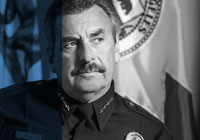On a recent morning in one of UCLA’s innumerable conference rooms, policymakers and researchers came together — in a way that’s all too rare — to fashion a way of making society better.
Los Angeles City Attorney Mike Feuer had made the trek from downtown to confer with Mark Kleiman, Greg Midgette and Brad Rowe, a team of UCLA researchers deeply immersed in Los Angeles criminal justice. The subject was drunken driving and some unexpected findings regarding the relationship between DUIs and violent crime.
The research team had combed through every DUI arrest in 2011 and then culled DUIs that resulted in accidents — 4,320 in all. Then the researchers looked at how many of those offenders had a previous conviction for a violent crime. They numbered about 6%. What was startling, however, is that those offenders accounted for more than 22% of the drunk drivers who were arrested after getting into a second accident.
Feuer quickly grasped the implications. If offenders could be diverted from drug or alcohol use after their first conviction — or even after their first DUI arrest — hundreds of accidents might be prevented every year. Lives might be saved. He left that morning promising to pursue a policy fix.
That’s how smart policy is made. The trouble is that this is the exception, not the rule.
And that’s where this magazine comes in. I spent more than two decades watching sausage being made in city, county and state government (and occasionally the school board), often baffled by the basis for decisions. Why doesn’t the subway go to the airport? Why does the region capture so little rainwater? Why do some drug offenders spend more time in prison than those convicted of violent crimes? The poison in each case is politics. The antidote is research.
Blueprint hopes to address that. We’ll publish two issues this year, with an eye toward ramping up to a quarterly once we have our bearings. Each issue will be built around a theme and will seek to present groundbreaking research — much of it from this university. We’ll also feature
profiles and interviews, and take stock of the interesting people and ideas at the center of this region’s civic life. And we’ll grow, too, making changes and adding features as we do.
This is a magazine, not an academic journal. It features the work of journalists — indeed, this issue contains the bylines of some of Southern California’s most highly regarded reporters, as well as the work of a talented and creative design team and the brilliant illustrations of Noma Bar. Blueprint’s job is to explain academic work, suggest ideas for change and engage readers and leaders in a conversation about how to tackle the most pressing problems of this region and state. It’s meant to start conversations, not finish them: At the foot of each story is contact information for the reporter and, in the cases of research pieces, the researcher or researchers responsible for the featured work. Our staff and contributor page also offers ways to contact us at Blueprint. We hope you’ll join us. If we succeed, maybe we’ll all get a little smarter and the region will run a little better.
Welcome to Blueprint.
Jim Newton
Editor in chief























